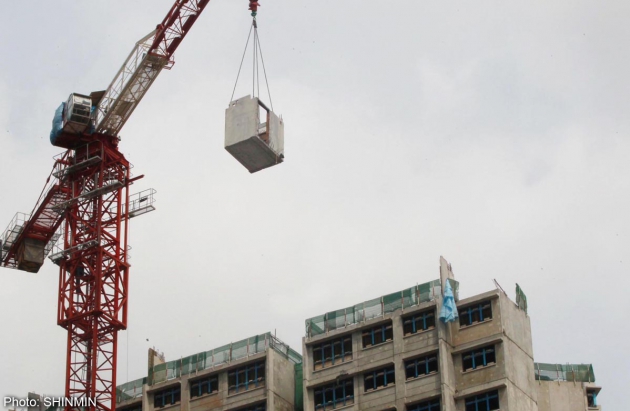A construction worker was standing on the 19th storey of an unfinished Sengkang HDB block when a 7,660kg prefabricated structure carried by a tower crane crashed into him.
Chinese national Liu Debao, 40, was initially pinned against the wire mesh barricades at the side of the unfinished building at Fernvale Street.
Then the barricades gave way and Mr Liu, who was from Shandong, fell to his death.
His colleague, who was operating the crane, claimed to have barely moved the controller joystick when the accident happened on Jan 23 last year.
But the crane had swung at its maximum speed, said Ministry of Manpower (MOM) investigation officer Larry Wong yesterday in an inquiry into Mr Liu’s death at the State Courts.
Initially, human error was suspected to be the cause of the accident as a check on the crane soon after the incident did not uncover any disconnected wires or damage, said Mr Wong.
But further investigation by MOM revealed that a possible design flaw of the tower crane was the most probable cause, which is possibly inherent in the 13 other such cranes used here.
This prompted State Coroner Marvin Bay to call for an advisory to be sent out to those using the same types of crane – the China-built Guohong QTZ250.
At about 2pm on the day of the accident, the crane was being used to lift a pre-cast bathroom unit, after four others were successfully installed earlier that day.
The crane operator, who had about 20 years’ experience, had manoeuvred the unit from the first storey to the 19th storey, where Mr Liu was standing.
Mr Liu, who was then working as a signal man, instructed his colleague to shift the bathroom unit to the right but the crane suddenly moved at high speed and the structure it was carrying crashed into him.
After rounds of simulation and testing, MOM officers found that a loose wiring connection – possibly caused by vibrations – could have caused the crane to swing at maximum speed once the operating joystick was moved, Mr Wong said.
The crane would then have continued moving at the highest speed even after the joystick was released and the only way to stop it was to press the emergency stop button.
SLOWEST GEAR
That day, the crane operator had engaged the first – and slowest – of four gears and had immediately released the joystick, said Mr Wong.
The Guohong QTZ250 was manufactured in Shandong before being shipped to Singapore, where it was assembled by an engineering company here, he said.
The crane is also used in China, Malaysia, Thailand and South Africa.
He also said MOM spoke to two other crane operators who had similar encounters with the Guohong QTZ250 before the fatal accident in January last year.
But they did not report the incidents because their cranes returned to normal after they hit the emergency stop button.
Their cranes were not carrying any loads then, Mr Wong said.
Mr Bay said he would deliver his findings at a later date, but asked that an advisory be quickly issued on the potential problems with the cranes.
“We don’t know when (an incident)… is going to happen. Could be tomorrow or next week,” Mr Bay said.
Mr Wong said MOM will be following up with companies using the cranes and the Chinese manufacturer. Police have ruled out foul play in the death of Mr Liu.
The case is expected to be heard again on June 4.
Author: Ronald Loh
Source:
http://news.asiaone.com/news/singapore/workers-death-due-crane-design-flaw


